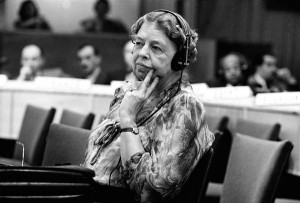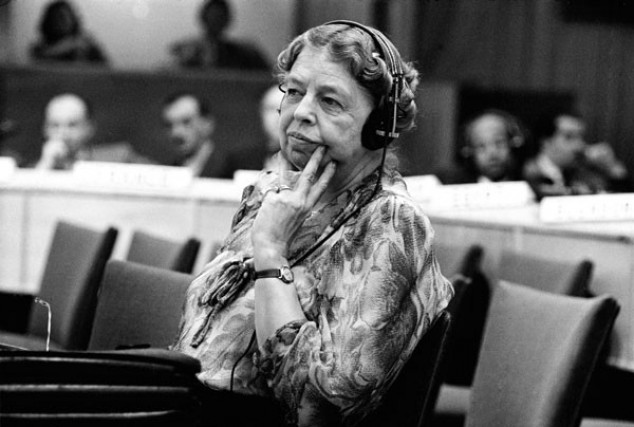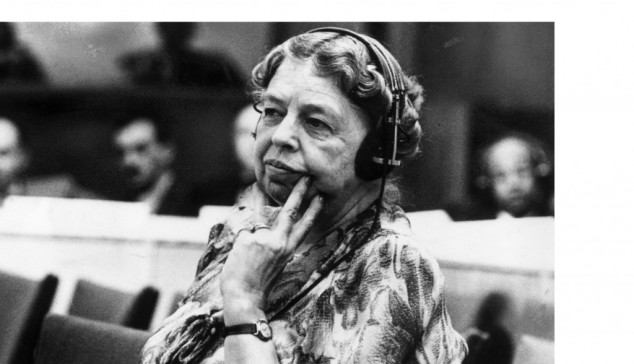The Evolving Role of the First Lady

Eleanor Roosevelt at the United Nations General Assembly working on the Universal Declaration of Human Rights in 1948
It’s said that behind every great president is a great first lady. While some first ladies have been merely a side note in history, others have stepped forward in a big way to change the nation and the world. First Ladies such as Eleanor Roosevelt, Hillary Clinton, and Michelle Obama changed not only the First Lady’s role in the White House, but perhaps even society’s perception of women’s role in the world. One of those First Ladies was Eleanor Roosevelt who in 1933, a time where women were not respected, became the first politically active first lady.
Talawanda High School American History teacher Stephanie Aerni concluded Eleanor Roosevelt had the most impact. “She [Eleanor Roosevelt] was probably the most influential [woman] of her time, as she can be credited with changing the role of the First Lady from a greeter to a political force.” One huge effect that Aerni attributes to Mrs. Roosevelt is encouraging her husband to run for office despite the fact that he had become ill with polio. Without her, one of America’s great Presidents may have never set foot in the Oval Office.
But Eleanor Roosevelt’s accomplishments were not only secondary. According to Aerni, “racial discrimination and human rights were her main focus.” She helped pass parts of FDR’s New Deal that focused on aiding impoverished racial groups. She also co-authored the United Nations’ Declaration of Human Rights. At a time when women were discouraged from taking leadership roles in the workplace, Eleanor Roosevelt was not only the most influential woman, but one of the most influential people of her time.
Ted Caudill, social studies teacher at Talawanda, agreed that Eleanor Roosevelt was the most influential First Lady, but noted that Hillary Clinton was another woman who redefined the role of the First Lady. Caudill had this to say, “….instead of only taking on non-partisan issues like traditional First Ladies, Hillary took on controversial issues and became a political force separate from her husband.” Hillary Clinton was given the task of leading healthcare reform, a far more politically divisive issue than any First Lady before had taken on.
In fact, Caudill pointed out she was so influential in policy making that she was able to have a successful political career after being first lady. Clinton served in The United States Senate as Secretary of State for President Obama, and is currently a ‘likely to win’, according to CNN, for the 2016 presidential race. Caudill mentioned that perhaps what separates Clinton from other First Ladies is that she herself is an effective politician. Anyone who makes it to the Oval Office is a skilled politician; typically their wives are not, but according to Caudill “Hillary was a politician.”
However, not all first ladies have to be political to be influential. Louise Anderson, World History teacher at Talawanda, cited the nation’s current first lady as being influential on nutrition for children.
“Michelle Obama is tackling childhood obesity and encouraging better nutrition.” Current First Lady Michelle Obama was who World History teacher, Anderson said is a influential first lady, while also agreeing that Eleanor Roosevelt was the most influential First Lady. Anderson said because of Obama’s work on programs such as “Let’s Move”, that she is one of the most influential first ladies. Let’s Move is a program that encourages children get out and exercise, and parents to feed their kids nutrient rich foods. This work may be especially important today because of the rise of type two diabetes in children.
There is no doubt that First Ladies have made an impact. Some have launched social programs to help Americans in need, others have spread awareness about something important, and a few have even been a political powerhouse. It is clear that since Eleanor Roosevelt, the role of the first lady has changed. First ladies are not just there to support their husband anymore, they have their own agendas and their influence can be see politically, socially, and economically.






